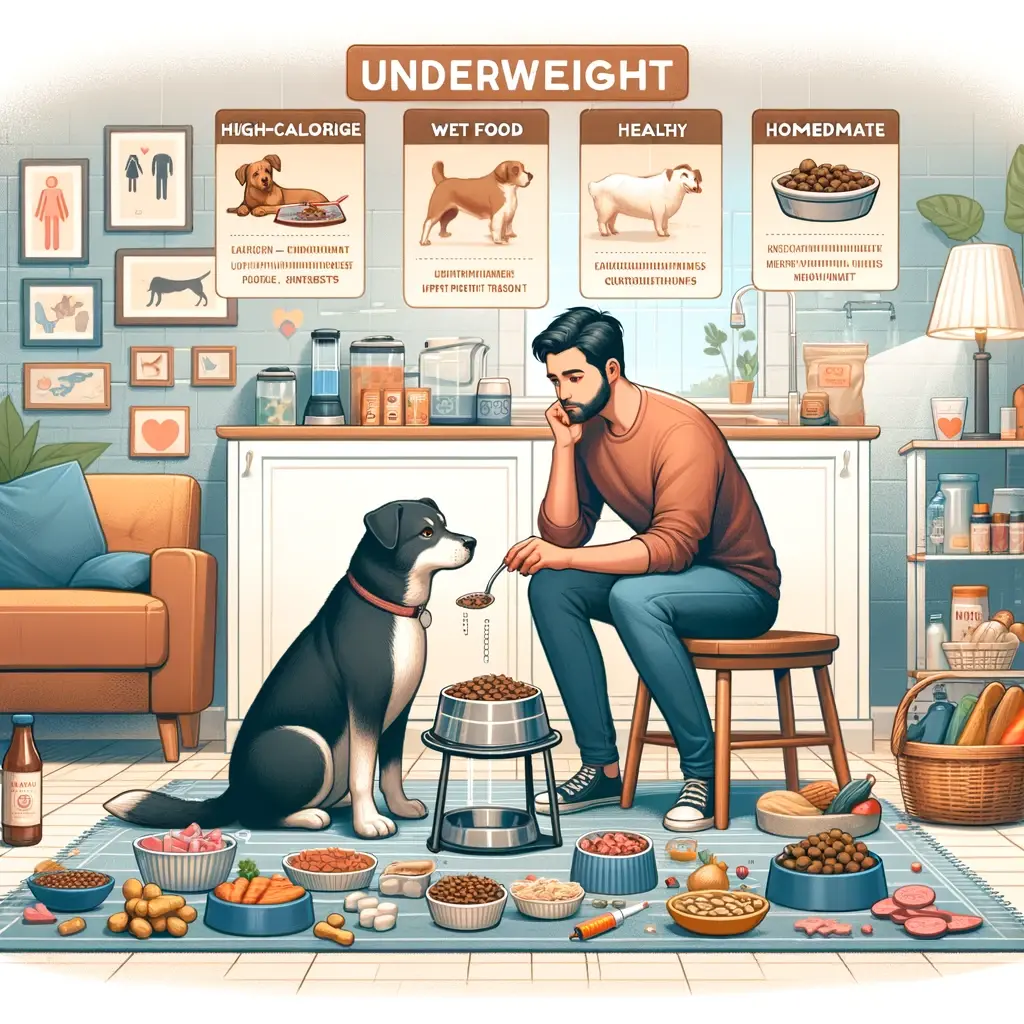How to Fatten up a Dog? Dogs have bigger hearts, and they only want to be loved and be loved in return. Pet dogs always share a precious bond with owners as they have mutual understanding due to their selflessness and loving nature.
How to Help Your Underweight Dog Gain Weight Safely
Seeing your furry friend underweight can be concerning. Here’s a comprehensive guide on how to fatten up a dog healthily and address any underlying medical issues:
Understanding Healthy Weight
- Ideal Body Condition: Assess your dog’s physique. You should be able to feel their ribs with a slight layer of fat, but they shouldn’t be visible from afar. Look for a defined waistline when viewed from above.
- Breed Variations: Some naturally lean breeds like Greyhounds and Whippets may have a more pronounced bone structure.
- Vet Consultation: Your veterinarian is the best judge of your dog’s ideal weight and can rule out any underlying health problems causing weight loss.
Reasons for Being Underweight
- Medical Conditions: Parasites, dental issues, diabetes, cancer, kidney or heart disease can lead to weight loss. A vet checkup is crucial.
- Stress or Anxiety: Changes in environment, new pets, or separation anxiety can affect eating habits.
- Diet: Poor quality food or insufficient calories can result in an underweight dog.
- Picky Eating: Some dogs are simply fussy eaters.
- High Activity Levels: Very active dogs might burn more calories than they consume.
Steps For Healthy Weight Gain
-
Veterinary Assessment: Get your dog checked for underlying health issues before focusing solely on weight gain.
-
High-Quality Diet: Choose a dog food with high protein and healthy fats for increased caloric intake. Consult your vet for specific recommendations.
-
Supplemental Feeding:
- Add wet food or cooked meat (chicken, lean beef) to dry kibble for extra calories and taste.
- Consider healthy, high-calorie treats in moderation.
- Offer small, frequent meals throughout the day instead of large portions.
-
Parasite Control: Regular deworming helps ensure your dog absorbs nutrients properly.
-
Reduce Stress: Provide a calm environment and consistent routines to minimize anxiety.
-
Gradual Increase: Increase food intake slowly to avoid digestive upset. Monitor weight gain regularly.
Additional Tips
- Homemade Food: Consult your vet for balanced homemade recipes to boost nutrition.
- Appetite Stimulants: Your vet might recommend medication if your dog refuses food.
- Exercise: Moderate exercise helps build muscle mass but adjust calorie intake accordingly.
Key Takeaways
- Patience is Key: Healthy weight gain takes time. It might take several weeks or months, depending on the severity.
- Work With Your Vet: They are your best ally in diagnosing and treating the root cause of weight loss while ensuring a safe weight gain plan.
- Focus on Overall Health: Weight gain is only part of the picture. Address any underlying conditions and promote your dog’s overall well-being.
Remember: A healthy weight means a happier, healthier dog! With proper care and guidance, your furry friend can achieve their ideal weight and thrive.
What is a Healthy Weight for the Dog?
Better quality of life and fewer chances of being seriously ill are the signs associated with a healthy weight for your dog. A healthy weight depends on its breed, age, and sex.
If you can feel the ribs of your pet dog through its body, but it is not visible from afar, your dog has a healthy weight. Your dog is considered underweight if the ribs or pelvis bones are visible from far.
Certain breeds like pugs, beagles, and Cocker Spaniels tend to gain more weight than the others. If your pet has been neutered, it is likely to gain more weight due to the procedure. The vet is the best person to guide you about your pet dog’s weight.
The vet will be able to let you know the ideal weight for your dog and how to reach the prescribed weight if it is less. It is vital to consult the vet as overfeeding your dog may make it obese.
Vets do not access the dog’s weight by the weighing machine. Vets see the muscle condition to determine if the dog is underweight or overweight.
Why is Your Dog Underweight?
Sometimes your dog may look healthy to you; however, it may be underweight. Some breeds do not gain weight even though they may eat more food, and some look small in size than others. Helping your dog maintain its weight increases its life span by 2.5 years.
The only way to determine if your pet is healthy and weighs correctly is to visit the vet. Dogs might lose or gain weight;
however, few medical conditions like parasites, diabetes, and teeth are responsible for rapid weight loss. Few signs like low energy levels, depression, and visible hips and ribs are indicators that your dog is underweight.
Reasons Why Your Dog Might be Losing Weight
Dogs lose weight now and then; however, sudden weight loss is a matter of concern for the owners. If your dog is eating all meals and losing weight, a visit to the vet is necessary.
Sometimes your dog might be losing weight as it might be burning calories due to exercise. Some of the common reasons why your dog might be losing weight are.
Stress
Many situations like meeting strangers or a new dog in the house can stress your pet. Your dog might eat less food due to anxiety issues. Any slight change in the surroundings may affect your pet, leading to weight loss due to stress.
Continuous stress may result in a weak immune system and increase the chances of infection.
Diet Changes
Change in your dog’s food also might result in weight loss. Sometimes a change in food may not provide the same nutrients to your pet as the previous diet, which could be the leading cause of weight loss.
Few dogs do not adjust to the diet change. Change in the taste of food also affects your pet’s intake. Hence before buying any dog food, ingredients need to be checked.
Dental Problems
Pain in the teeth, abscessed teeth, and inflammation of gums may lead to your pet not having proper food due to pain. If your dog has painful jaw or jaw muscles, chewing food causes pain.
Dogs with dental issues may start falling ill. Oral bacteria can spread and lead to painful infections in the kidneys or liver. Regular cleaning of teeth may help solve dental problems.
Parasites
Parasites generally affect the digestive system and the intestines resulting in loss of appetite. They may also eradicate the nutrients of the food consumed by your pet.
Most parasites can be treated with medicines; however, few parasites like heartworms require surgery. Pets suffer from whipworms due to the intake of contaminated water or soil.
Cancer
Cancer is another cause of weight loss in your pets. It is found more in older dogs, and malign forms of cancer are life-threatening. Few types of cancer do not show symptoms unless they spread.
Weight loss is more common in toxic cancers like lymphoma, osteosarcoma, and hemangiosarcoma. Once your dog’s appetite becomes less due to pain and discomfort, it results in weight loss. Few cancers like oral melanoma cause pain while eating and swallowing.
Your pet might respond to chemotherapy or the removal of cancerous tumors. You will have to consult your vet for any treatment for your pet.
Heart Disease
Dogs with heart problems do not start showing symptoms right at the start. Sometimes dogs with heart problems initially start gaining weight due to fluid accumulation in their body.
If your pet has lost weight, you can add more calories to its diet. If your pet has more food and puts the weight back on, you have no reason to worry.
You will have to keep your pet’s food separate to avoid sharing or stealing. Avoid feeding your dog with treats.
Kidney Disease
Weight loss in pets with kidney problems does not happen overnight. It occurs only when the disease is severe. If you notice weight loss due to a kidney problem, your pet has been suffering from this problem for a long time.
Once the disease is in a later stage, your pet might have to deal with appetite loss, vomiting, and dehydration. Here weight loss affects the body fat and muscle. Treatment of the kidney depends on your dog’s symptoms if the condition is acute or severe.
how to fatten up a malnourished dog?
If your dog is malnourished, it is important to work with your veterinarian to develop a plan to help them gain weight and improve their overall health. Here are some steps you can take to fatten up a malnourished dog:
- Consult with your veterinarian. Malnourishment can be a serious and potentially life-threatening condition, and it is important to work with your veterinarian to develop a plan to help your dog gain weight and improve their health.
- Feed your dog a high-calorie, nutrient-rich diet. Malnourished dogs often need more calories and nutrients than healthy dogs, so it is important to feed them a diet that is high in calories and rich in essential vitamins and minerals. Your veterinarian can recommend a specific diet for your dog based on their individual needs.
- Use a feeding schedule. Establishing a regular feeding schedule can help to regulate your dog’s appetite and to ensure that they are getting the right amount of food at the right times. This can also help to prevent overfeeding, which can lead to weight gain and other health problems.
- Provide your dog with plenty of fresh water. Dehydration can be a common problem in malnourished dogs, so it is important to provide your dog with plenty of fresh, clean water at all times. This will help to keep them hydrated and to support their overall health.
- Monitor your dog’s progress. Keep track of your dog’s weight and overall health, and work closely with your veterinarian to monitor their progress. This will help to ensure that they are gaining weight at a healthy rate and that they are receiving the right nutrition to support their recovery.
- Give them homemade food. A homemade food should have a proper daily protein, fiber, fat, and carbohydrates balance. Vitamins and minerals are also required to complete the meal. You have to ensure that your pet is not allergic to any ingredient.
- If needed can give energy supplements but must ask Vet which one should we give and in what quantity
- Regular deworming is required for your pets as worms fight for food in the dog’s bowel and cause body condition to deteriorate since the worms remove the nutrition from your dog’s body. Dogs with more worms have a potbelly; however, they lose fats from the ribs and hips
- Exercise is helpful as it helps build dog muscle, and increased activity will also lead to an increase in appetite. When you change your pet’s diet, check with your vet for regular exercise to match it.
Overall, it is important to work closely with your veterinarian to provide the best care for your malnourished dog. With the right treatment and care, you can help your dog to gain weight and to improve their overall health.Try again
How to Tell if Your Dog is at a Healthy Weight?
Underweight and overweight dogs are at a high risk of health issues that can shorten their life. As a dog owner, it is your responsibility to feed your pet with a balanced diet and exercise. By eating a proper diet, dogs can live two years longer.
A visit to the vet might help you know the requirements of your pet canine. To know if your dog is overweight or underweight, you will have to check your dog’s profile.
Dogs can be underweight due to certain medical conditions. You can provide your dog with food at intervals and substitute dry food like kibbles with fresh wet food. Breaking down larger meals into small meals will be easy for your pet to digest.
If your pet refuses to eat food, your vet will advise you to switch to dog formula food to gain weight. Once your dog has reached the recommended weight, you have to see that your dog gets plenty of exercise to maintain the balance.
Feel the Ribs
You will have to feel the ribs by placing your thumbs on your dog’s spine and opening your hands over its ribcage.
You will feel the ribs if your pet is healthy. If you are unable to count the ribs, your pet might be carrying more weight than required. You will have to feel the ribs with your hands and not your eyes, as a dog’s fur obscures its ribcage.
Check its Spine
You will have to feel the length of your pet’s spine. If you can feel the spine properly, it means that your dog’s weight is as required, and if you struggle to handle the spine, it means that your pet is overweight.
Check Full Body, Including Waist and Belly
When your dog has an appropriate weight, you will be able to see it by standing in front of its face and looking down. The waist will be tucked behind the ribs. The belly will be inserted in from the sides when looking at your pet.
When the ribs and waist appear to be narrower than its ribs, it indicates that your pet is underweight, and a bulging waist would mean it is overweight.


